Impairment Loss in Accounting: Treatment, Valuation, and Guidelines for Cash Generating Units
VerifiedAdded on 2023/04/24
|9
|1395
|381
Assignment
AI Summary
In this document we will discuss about Impairment Loss in Accounting and below are the summary points of this document:-
The text discusses the recognition and treatment of impairment loss in financial statements according to Australia's accounting principles.
Impairment loss occurs when the carrying amount of an asset exceeds its recoverable amount, resulting in overvaluation.
AASB 136 provides guidelines for impairment testing, including cash generating units, and the calculation of impairment loss involves comparing the carrying amount to the recoverable amount.
Contribute Materials
Your contribution can guide someone’s learning journey. Share your
documents today.
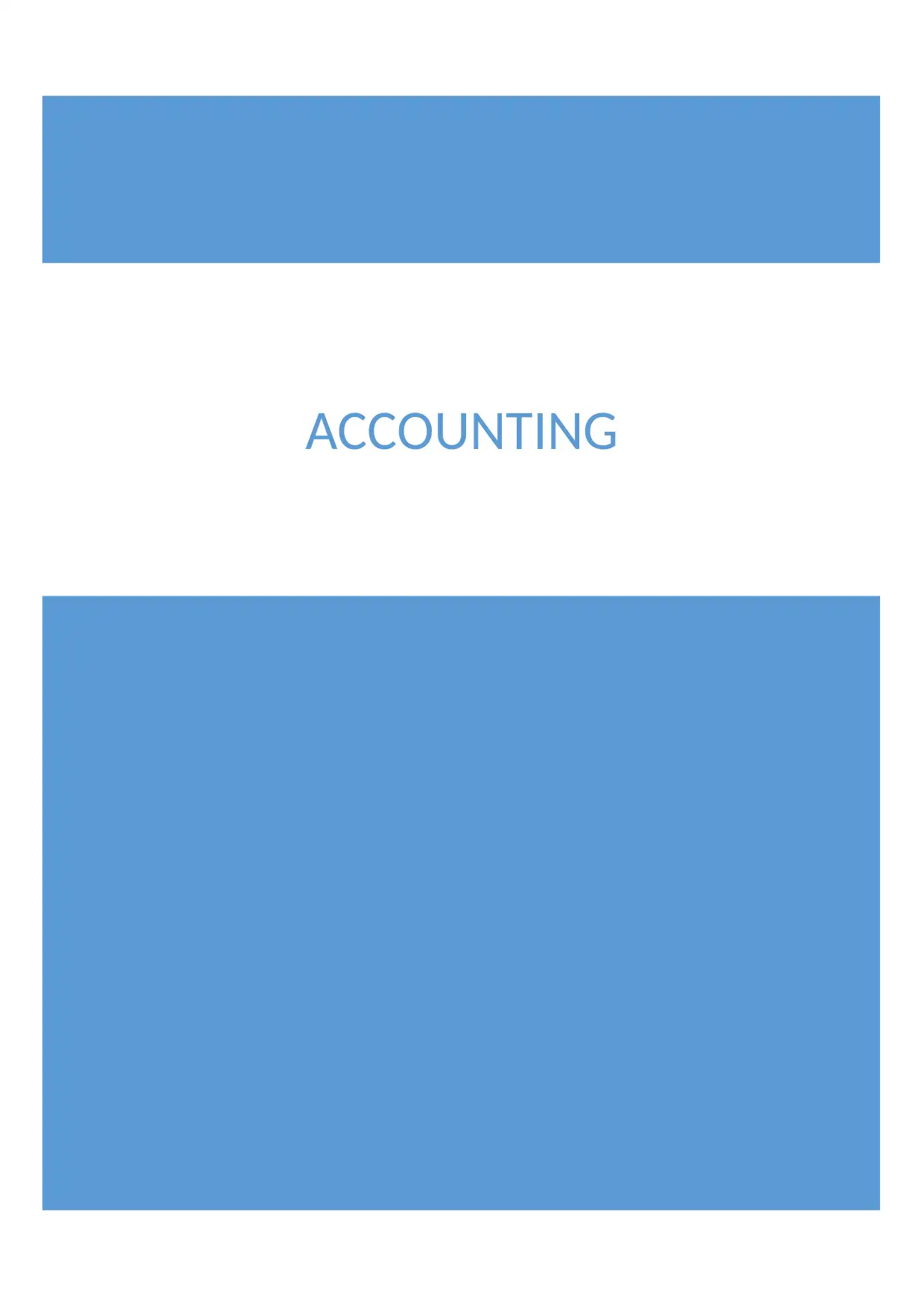
ACCOUNTING
Secure Best Marks with AI Grader
Need help grading? Try our AI Grader for instant feedback on your assignments.
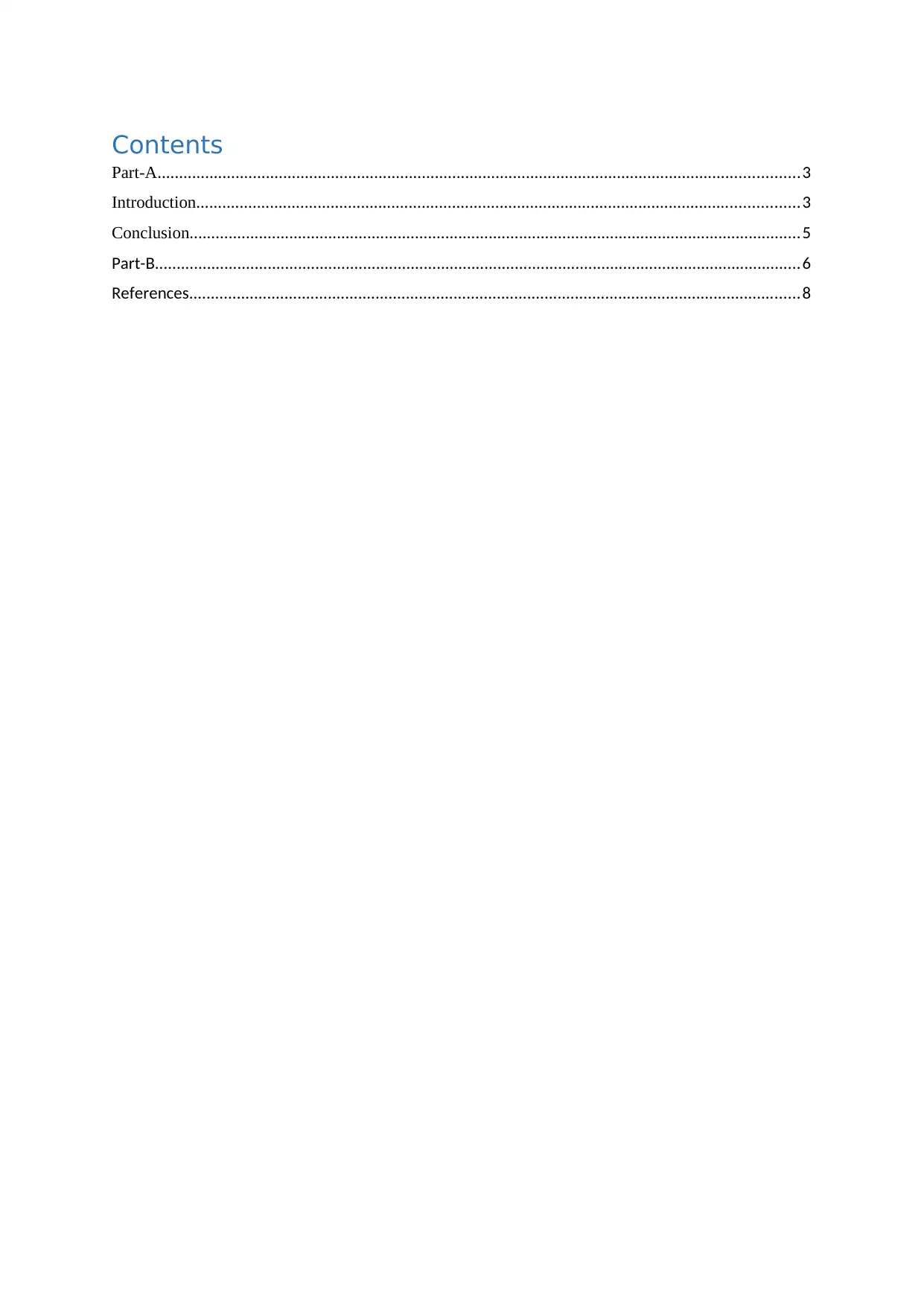
Contents
Part-A....................................................................................................................................................3
Introduction...........................................................................................................................................3
Conclusion.............................................................................................................................................5
Part-B.....................................................................................................................................................6
References.............................................................................................................................................8
Part-A....................................................................................................................................................3
Introduction...........................................................................................................................................3
Conclusion.............................................................................................................................................5
Part-B.....................................................................................................................................................6
References.............................................................................................................................................8
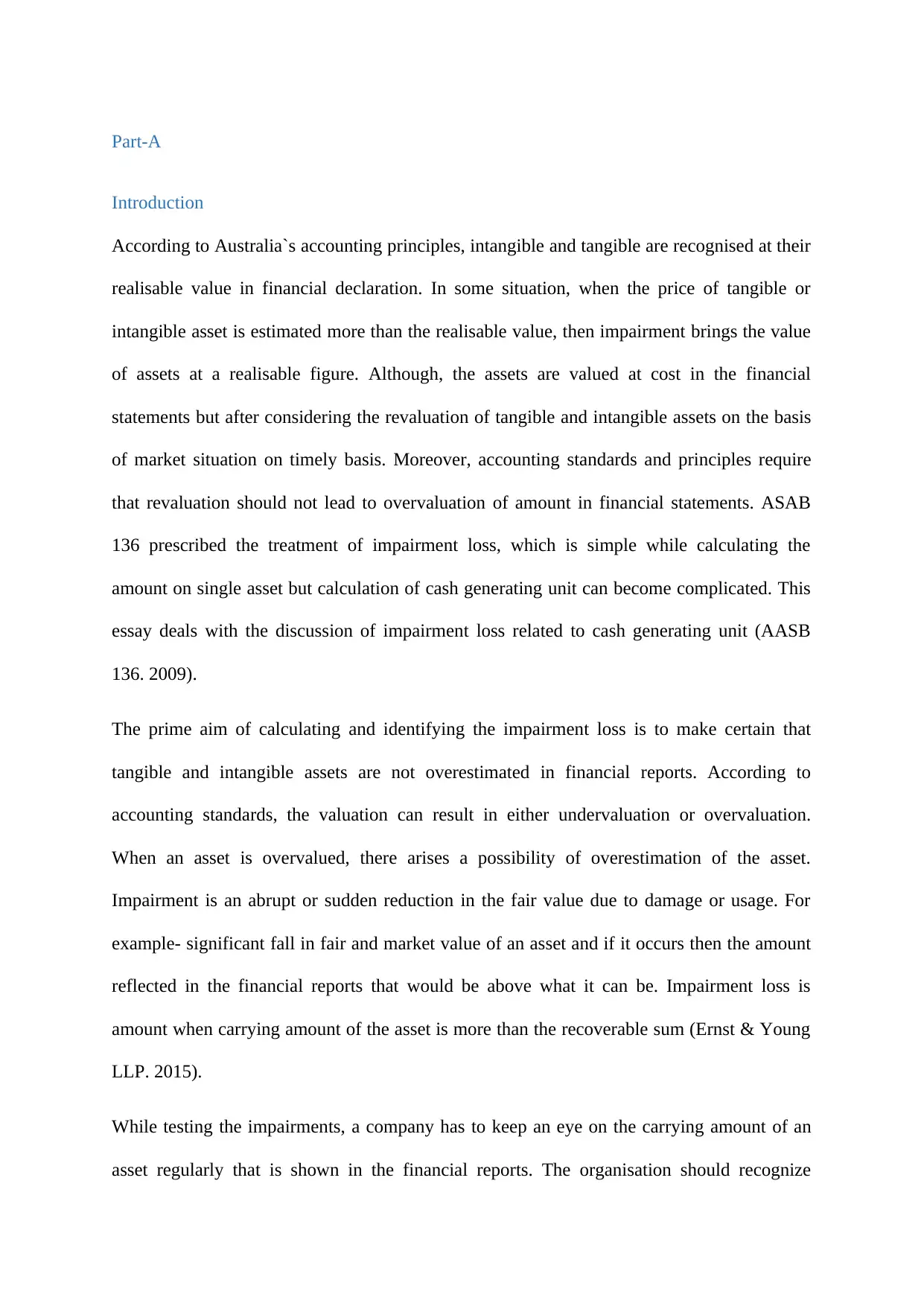
Part-A
Introduction
According to Australia`s accounting principles, intangible and tangible are recognised at their
realisable value in financial declaration. In some situation, when the price of tangible or
intangible asset is estimated more than the realisable value, then impairment brings the value
of assets at a realisable figure. Although, the assets are valued at cost in the financial
statements but after considering the revaluation of tangible and intangible assets on the basis
of market situation on timely basis. Moreover, accounting standards and principles require
that revaluation should not lead to overvaluation of amount in financial statements. ASAB
136 prescribed the treatment of impairment loss, which is simple while calculating the
amount on single asset but calculation of cash generating unit can become complicated. This
essay deals with the discussion of impairment loss related to cash generating unit (AASB
136. 2009).
The prime aim of calculating and identifying the impairment loss is to make certain that
tangible and intangible assets are not overestimated in financial reports. According to
accounting standards, the valuation can result in either undervaluation or overvaluation.
When an asset is overvalued, there arises a possibility of overestimation of the asset.
Impairment is an abrupt or sudden reduction in the fair value due to damage or usage. For
example- significant fall in fair and market value of an asset and if it occurs then the amount
reflected in the financial reports that would be above what it can be. Impairment loss is
amount when carrying amount of the asset is more than the recoverable sum (Ernst & Young
LLP. 2015).
While testing the impairments, a company has to keep an eye on the carrying amount of an
asset regularly that is shown in the financial reports. The organisation should recognize
Introduction
According to Australia`s accounting principles, intangible and tangible are recognised at their
realisable value in financial declaration. In some situation, when the price of tangible or
intangible asset is estimated more than the realisable value, then impairment brings the value
of assets at a realisable figure. Although, the assets are valued at cost in the financial
statements but after considering the revaluation of tangible and intangible assets on the basis
of market situation on timely basis. Moreover, accounting standards and principles require
that revaluation should not lead to overvaluation of amount in financial statements. ASAB
136 prescribed the treatment of impairment loss, which is simple while calculating the
amount on single asset but calculation of cash generating unit can become complicated. This
essay deals with the discussion of impairment loss related to cash generating unit (AASB
136. 2009).
The prime aim of calculating and identifying the impairment loss is to make certain that
tangible and intangible assets are not overestimated in financial reports. According to
accounting standards, the valuation can result in either undervaluation or overvaluation.
When an asset is overvalued, there arises a possibility of overestimation of the asset.
Impairment is an abrupt or sudden reduction in the fair value due to damage or usage. For
example- significant fall in fair and market value of an asset and if it occurs then the amount
reflected in the financial reports that would be above what it can be. Impairment loss is
amount when carrying amount of the asset is more than the recoverable sum (Ernst & Young
LLP. 2015).
While testing the impairments, a company has to keep an eye on the carrying amount of an
asset regularly that is shown in the financial reports. The organisation should recognize
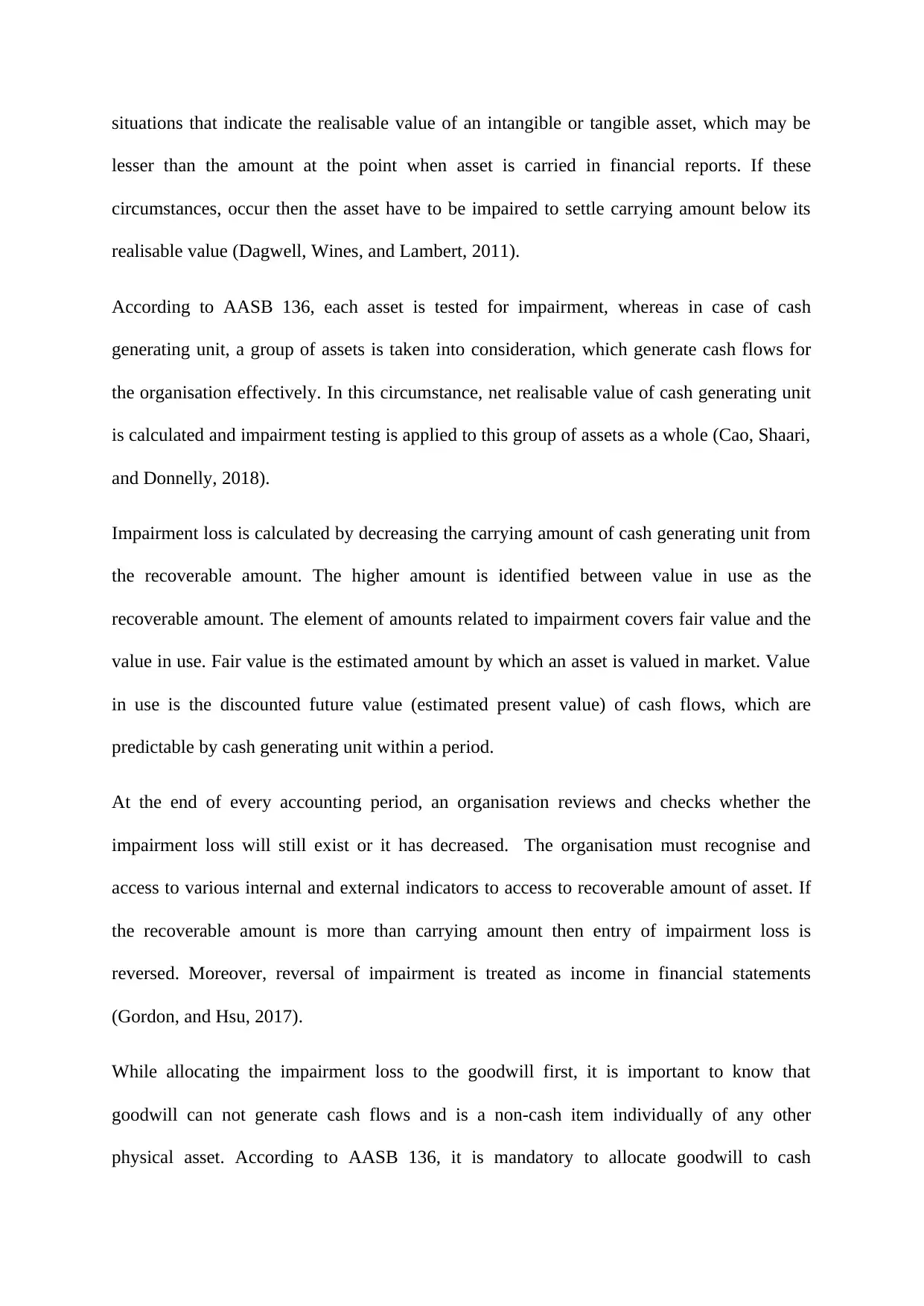
situations that indicate the realisable value of an intangible or tangible asset, which may be
lesser than the amount at the point when asset is carried in financial reports. If these
circumstances, occur then the asset have to be impaired to settle carrying amount below its
realisable value (Dagwell, Wines, and Lambert, 2011).
According to AASB 136, each asset is tested for impairment, whereas in case of cash
generating unit, a group of assets is taken into consideration, which generate cash flows for
the organisation effectively. In this circumstance, net realisable value of cash generating unit
is calculated and impairment testing is applied to this group of assets as a whole (Cao, Shaari,
and Donnelly, 2018).
Impairment loss is calculated by decreasing the carrying amount of cash generating unit from
the recoverable amount. The higher amount is identified between value in use as the
recoverable amount. The element of amounts related to impairment covers fair value and the
value in use. Fair value is the estimated amount by which an asset is valued in market. Value
in use is the discounted future value (estimated present value) of cash flows, which are
predictable by cash generating unit within a period.
At the end of every accounting period, an organisation reviews and checks whether the
impairment loss will still exist or it has decreased. The organisation must recognise and
access to various internal and external indicators to access to recoverable amount of asset. If
the recoverable amount is more than carrying amount then entry of impairment loss is
reversed. Moreover, reversal of impairment is treated as income in financial statements
(Gordon, and Hsu, 2017).
While allocating the impairment loss to the goodwill first, it is important to know that
goodwill can not generate cash flows and is a non-cash item individually of any other
physical asset. According to AASB 136, it is mandatory to allocate goodwill to cash
lesser than the amount at the point when asset is carried in financial reports. If these
circumstances, occur then the asset have to be impaired to settle carrying amount below its
realisable value (Dagwell, Wines, and Lambert, 2011).
According to AASB 136, each asset is tested for impairment, whereas in case of cash
generating unit, a group of assets is taken into consideration, which generate cash flows for
the organisation effectively. In this circumstance, net realisable value of cash generating unit
is calculated and impairment testing is applied to this group of assets as a whole (Cao, Shaari,
and Donnelly, 2018).
Impairment loss is calculated by decreasing the carrying amount of cash generating unit from
the recoverable amount. The higher amount is identified between value in use as the
recoverable amount. The element of amounts related to impairment covers fair value and the
value in use. Fair value is the estimated amount by which an asset is valued in market. Value
in use is the discounted future value (estimated present value) of cash flows, which are
predictable by cash generating unit within a period.
At the end of every accounting period, an organisation reviews and checks whether the
impairment loss will still exist or it has decreased. The organisation must recognise and
access to various internal and external indicators to access to recoverable amount of asset. If
the recoverable amount is more than carrying amount then entry of impairment loss is
reversed. Moreover, reversal of impairment is treated as income in financial statements
(Gordon, and Hsu, 2017).
While allocating the impairment loss to the goodwill first, it is important to know that
goodwill can not generate cash flows and is a non-cash item individually of any other
physical asset. According to AASB 136, it is mandatory to allocate goodwill to cash
Secure Best Marks with AI Grader
Need help grading? Try our AI Grader for instant feedback on your assignments.
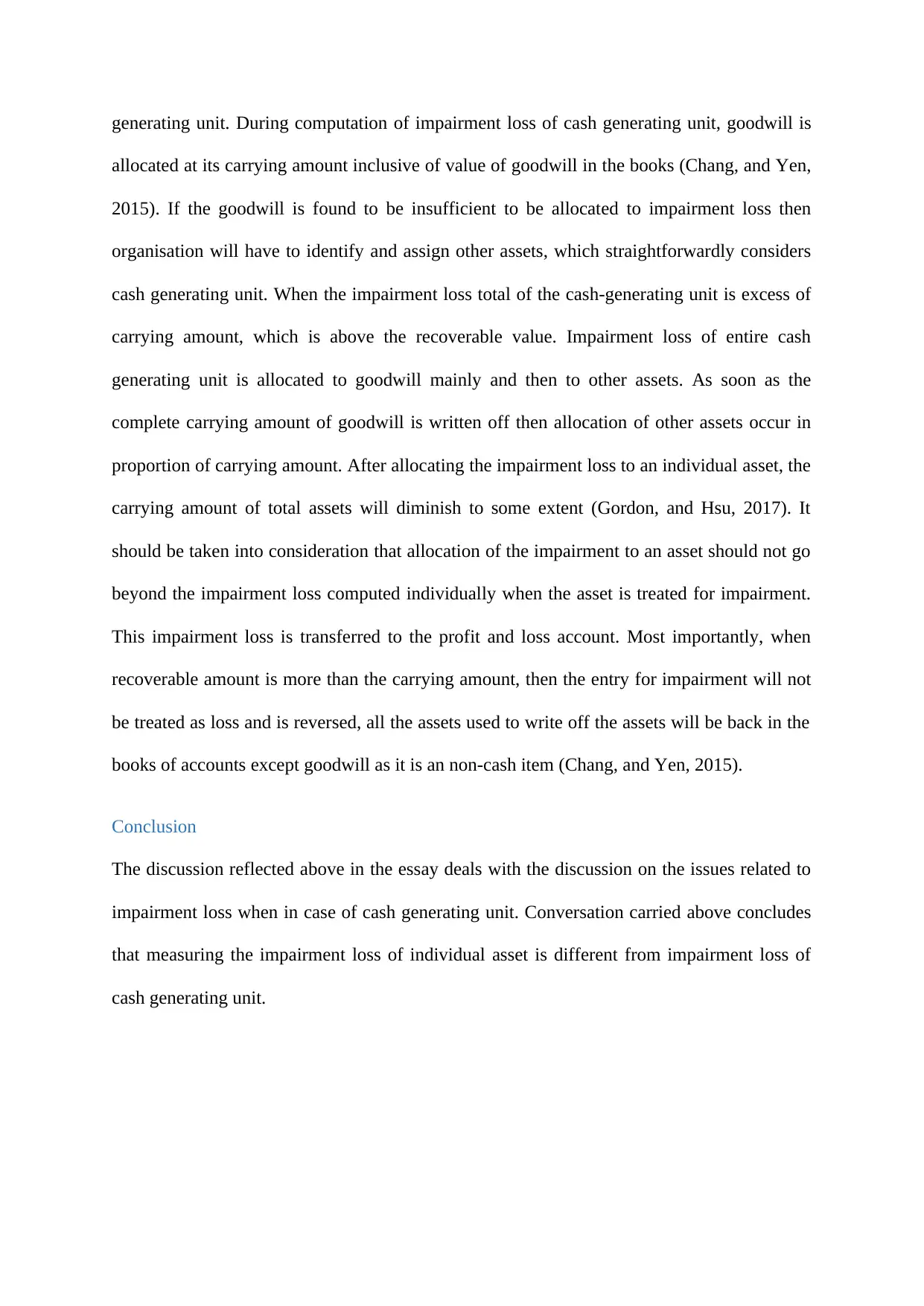
generating unit. During computation of impairment loss of cash generating unit, goodwill is
allocated at its carrying amount inclusive of value of goodwill in the books (Chang, and Yen,
2015). If the goodwill is found to be insufficient to be allocated to impairment loss then
organisation will have to identify and assign other assets, which straightforwardly considers
cash generating unit. When the impairment loss total of the cash-generating unit is excess of
carrying amount, which is above the recoverable value. Impairment loss of entire cash
generating unit is allocated to goodwill mainly and then to other assets. As soon as the
complete carrying amount of goodwill is written off then allocation of other assets occur in
proportion of carrying amount. After allocating the impairment loss to an individual asset, the
carrying amount of total assets will diminish to some extent (Gordon, and Hsu, 2017). It
should be taken into consideration that allocation of the impairment to an asset should not go
beyond the impairment loss computed individually when the asset is treated for impairment.
This impairment loss is transferred to the profit and loss account. Most importantly, when
recoverable amount is more than the carrying amount, then the entry for impairment will not
be treated as loss and is reversed, all the assets used to write off the assets will be back in the
books of accounts except goodwill as it is an non-cash item (Chang, and Yen, 2015).
Conclusion
The discussion reflected above in the essay deals with the discussion on the issues related to
impairment loss when in case of cash generating unit. Conversation carried above concludes
that measuring the impairment loss of individual asset is different from impairment loss of
cash generating unit.
allocated at its carrying amount inclusive of value of goodwill in the books (Chang, and Yen,
2015). If the goodwill is found to be insufficient to be allocated to impairment loss then
organisation will have to identify and assign other assets, which straightforwardly considers
cash generating unit. When the impairment loss total of the cash-generating unit is excess of
carrying amount, which is above the recoverable value. Impairment loss of entire cash
generating unit is allocated to goodwill mainly and then to other assets. As soon as the
complete carrying amount of goodwill is written off then allocation of other assets occur in
proportion of carrying amount. After allocating the impairment loss to an individual asset, the
carrying amount of total assets will diminish to some extent (Gordon, and Hsu, 2017). It
should be taken into consideration that allocation of the impairment to an asset should not go
beyond the impairment loss computed individually when the asset is treated for impairment.
This impairment loss is transferred to the profit and loss account. Most importantly, when
recoverable amount is more than the carrying amount, then the entry for impairment will not
be treated as loss and is reversed, all the assets used to write off the assets will be back in the
books of accounts except goodwill as it is an non-cash item (Chang, and Yen, 2015).
Conclusion
The discussion reflected above in the essay deals with the discussion on the issues related to
impairment loss when in case of cash generating unit. Conversation carried above concludes
that measuring the impairment loss of individual asset is different from impairment loss of
cash generating unit.
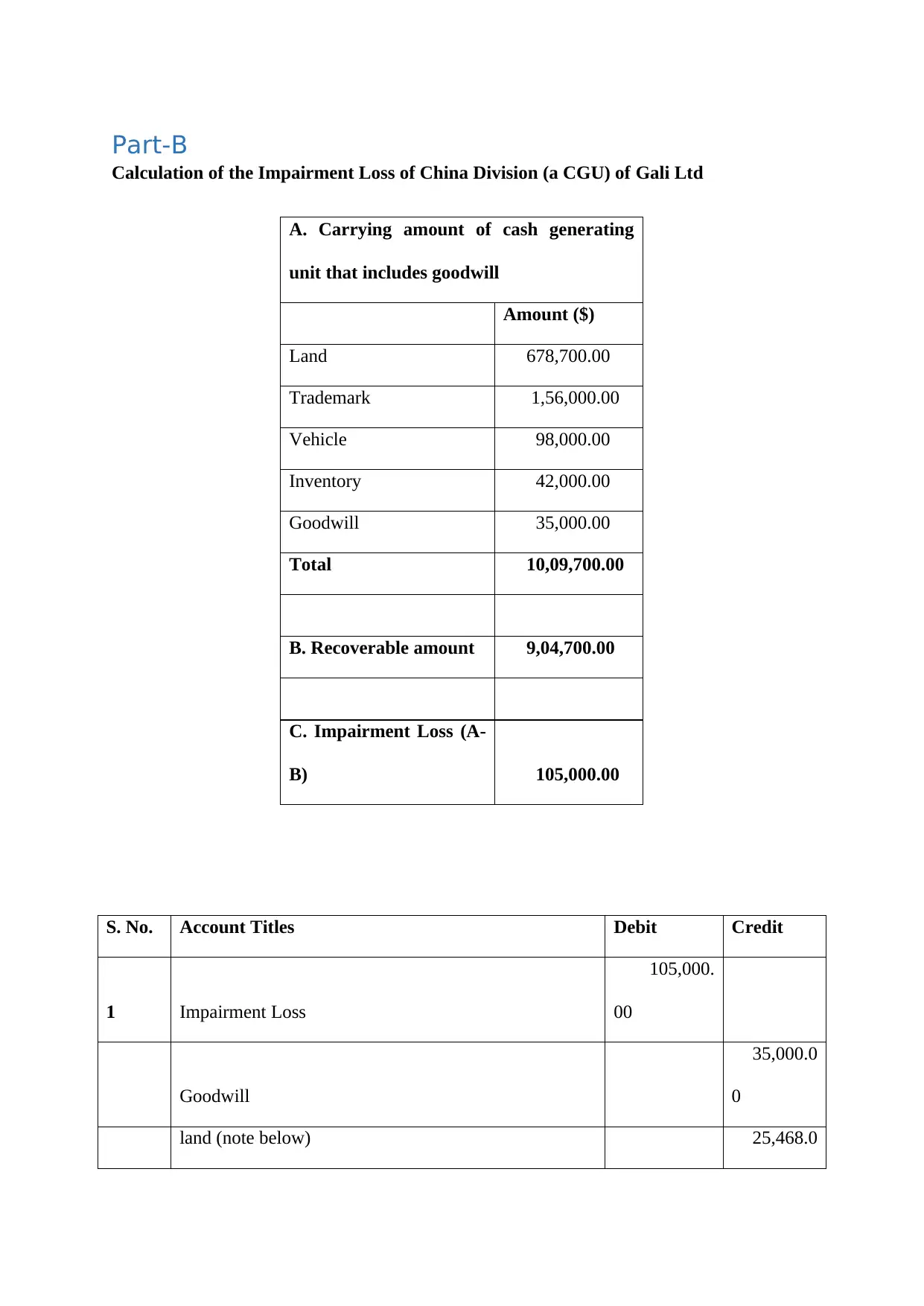
Part-B
Calculation of the Impairment Loss of China Division (a CGU) of Gali Ltd
A. Carrying amount of cash generating
unit that includes goodwill
Amount ($)
Land 678,700.00
Trademark 1,56,000.00
Vehicle 98,000.00
Inventory 42,000.00
Goodwill 35,000.00
Total 10,09,700.00
B. Recoverable amount 9,04,700.00
C. Impairment Loss (A-
B) 105,000.00
S. No. Account Titles Debit Credit
1 Impairment Loss
105,000.
00
Goodwill
35,000.0
0
land (note below) 25,468.0
Calculation of the Impairment Loss of China Division (a CGU) of Gali Ltd
A. Carrying amount of cash generating
unit that includes goodwill
Amount ($)
Land 678,700.00
Trademark 1,56,000.00
Vehicle 98,000.00
Inventory 42,000.00
Goodwill 35,000.00
Total 10,09,700.00
B. Recoverable amount 9,04,700.00
C. Impairment Loss (A-
B) 105,000.00
S. No. Account Titles Debit Credit
1 Impairment Loss
105,000.
00
Goodwill
35,000.0
0
land (note below) 25,468.0
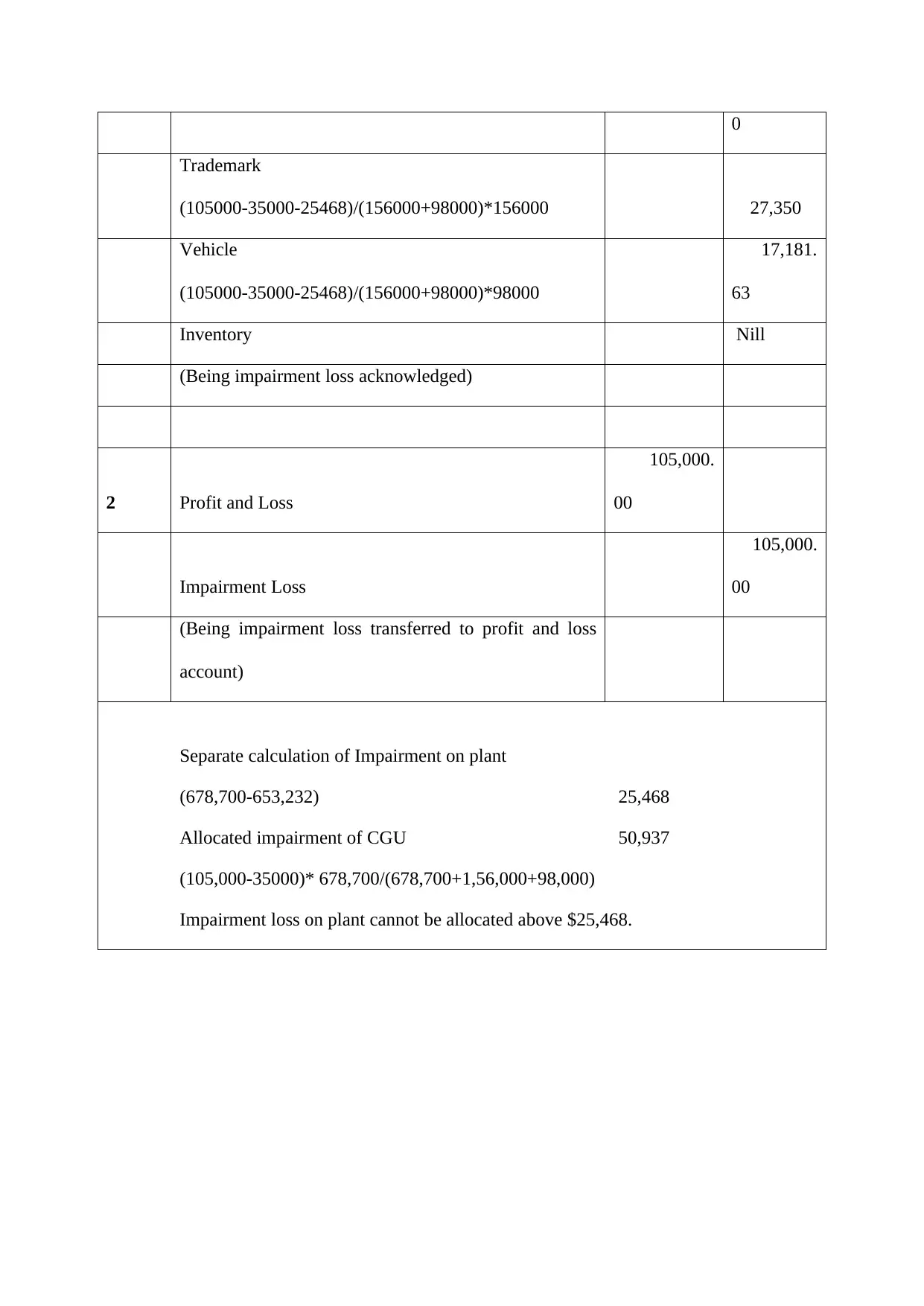
0
Trademark
(105000-35000-25468)/(156000+98000)*156000 27,350
Vehicle
(105000-35000-25468)/(156000+98000)*98000
17,181.
63
Inventory Nill
(Being impairment loss acknowledged)
2 Profit and Loss
105,000.
00
Impairment Loss
105,000.
00
(Being impairment loss transferred to profit and loss
account)
Separate calculation of Impairment on plant
(678,700-653,232) 25,468
Allocated impairment of CGU 50,937
(105,000-35000)* 678,700/(678,700+1,56,000+98,000)
Impairment loss on plant cannot be allocated above $25,468.
Trademark
(105000-35000-25468)/(156000+98000)*156000 27,350
Vehicle
(105000-35000-25468)/(156000+98000)*98000
17,181.
63
Inventory Nill
(Being impairment loss acknowledged)
2 Profit and Loss
105,000.
00
Impairment Loss
105,000.
00
(Being impairment loss transferred to profit and loss
account)
Separate calculation of Impairment on plant
(678,700-653,232) 25,468
Allocated impairment of CGU 50,937
(105,000-35000)* 678,700/(678,700+1,56,000+98,000)
Impairment loss on plant cannot be allocated above $25,468.
Paraphrase This Document
Need a fresh take? Get an instant paraphrase of this document with our AI Paraphraser
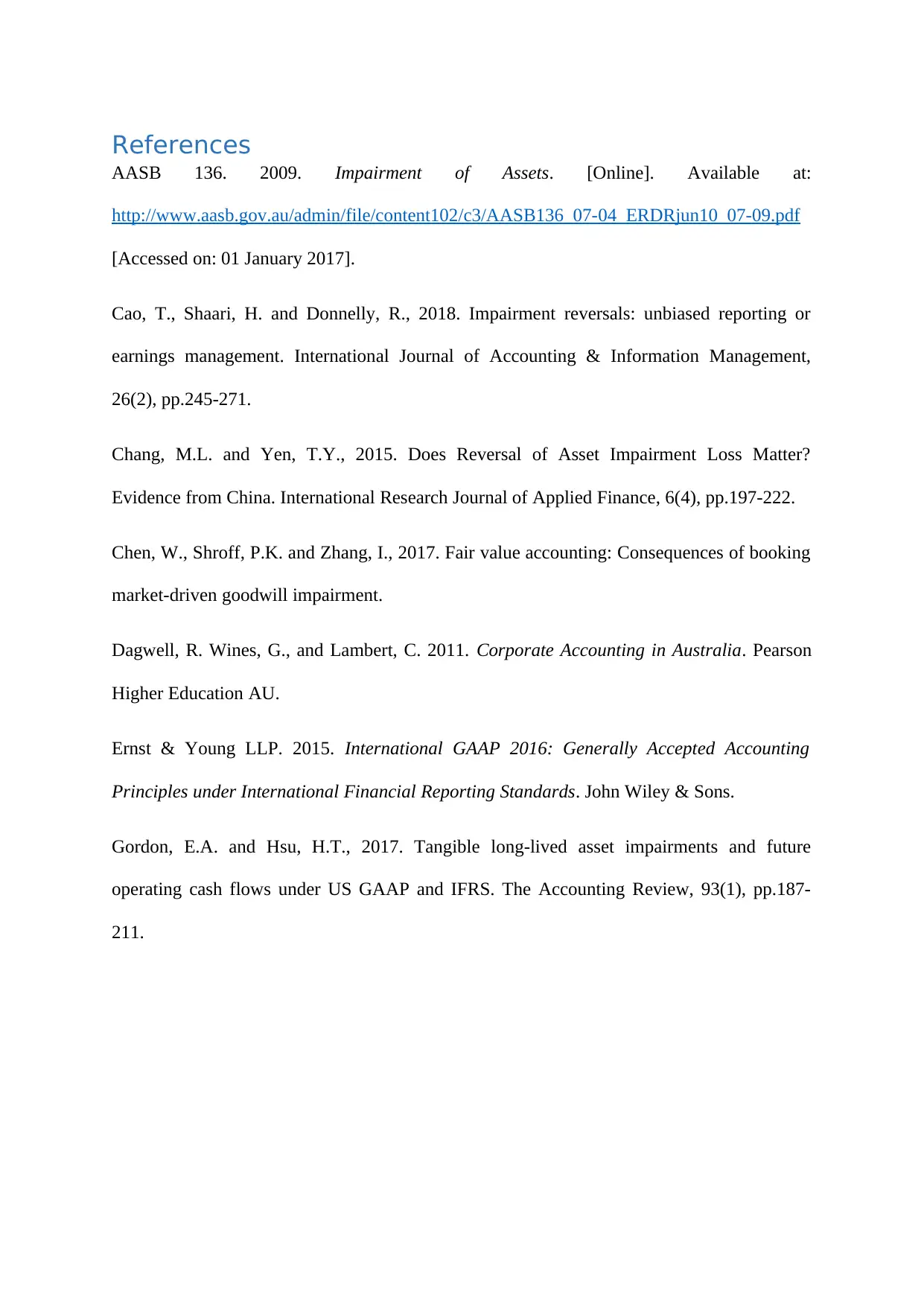
References
AASB 136. 2009. Impairment of Assets. [Online]. Available at:
http://www.aasb.gov.au/admin/file/content102/c3/AASB136_07-04_ERDRjun10_07-09.pdf
[Accessed on: 01 January 2017].
Cao, T., Shaari, H. and Donnelly, R., 2018. Impairment reversals: unbiased reporting or
earnings management. International Journal of Accounting & Information Management,
26(2), pp.245-271.
Chang, M.L. and Yen, T.Y., 2015. Does Reversal of Asset Impairment Loss Matter?
Evidence from China. International Research Journal of Applied Finance, 6(4), pp.197-222.
Chen, W., Shroff, P.K. and Zhang, I., 2017. Fair value accounting: Consequences of booking
market-driven goodwill impairment.
Dagwell, R. Wines, G., and Lambert, C. 2011. Corporate Accounting in Australia. Pearson
Higher Education AU.
Ernst & Young LLP. 2015. International GAAP 2016: Generally Accepted Accounting
Principles under International Financial Reporting Standards. John Wiley & Sons.
Gordon, E.A. and Hsu, H.T., 2017. Tangible long-lived asset impairments and future
operating cash flows under US GAAP and IFRS. The Accounting Review, 93(1), pp.187-
211.
AASB 136. 2009. Impairment of Assets. [Online]. Available at:
http://www.aasb.gov.au/admin/file/content102/c3/AASB136_07-04_ERDRjun10_07-09.pdf
[Accessed on: 01 January 2017].
Cao, T., Shaari, H. and Donnelly, R., 2018. Impairment reversals: unbiased reporting or
earnings management. International Journal of Accounting & Information Management,
26(2), pp.245-271.
Chang, M.L. and Yen, T.Y., 2015. Does Reversal of Asset Impairment Loss Matter?
Evidence from China. International Research Journal of Applied Finance, 6(4), pp.197-222.
Chen, W., Shroff, P.K. and Zhang, I., 2017. Fair value accounting: Consequences of booking
market-driven goodwill impairment.
Dagwell, R. Wines, G., and Lambert, C. 2011. Corporate Accounting in Australia. Pearson
Higher Education AU.
Ernst & Young LLP. 2015. International GAAP 2016: Generally Accepted Accounting
Principles under International Financial Reporting Standards. John Wiley & Sons.
Gordon, E.A. and Hsu, H.T., 2017. Tangible long-lived asset impairments and future
operating cash flows under US GAAP and IFRS. The Accounting Review, 93(1), pp.187-
211.

1 out of 9
Related Documents
Your All-in-One AI-Powered Toolkit for Academic Success.
+13062052269
info@desklib.com
Available 24*7 on WhatsApp / Email
![[object Object]](/_next/static/media/star-bottom.7253800d.svg)
Unlock your academic potential
© 2024 | Zucol Services PVT LTD | All rights reserved.





